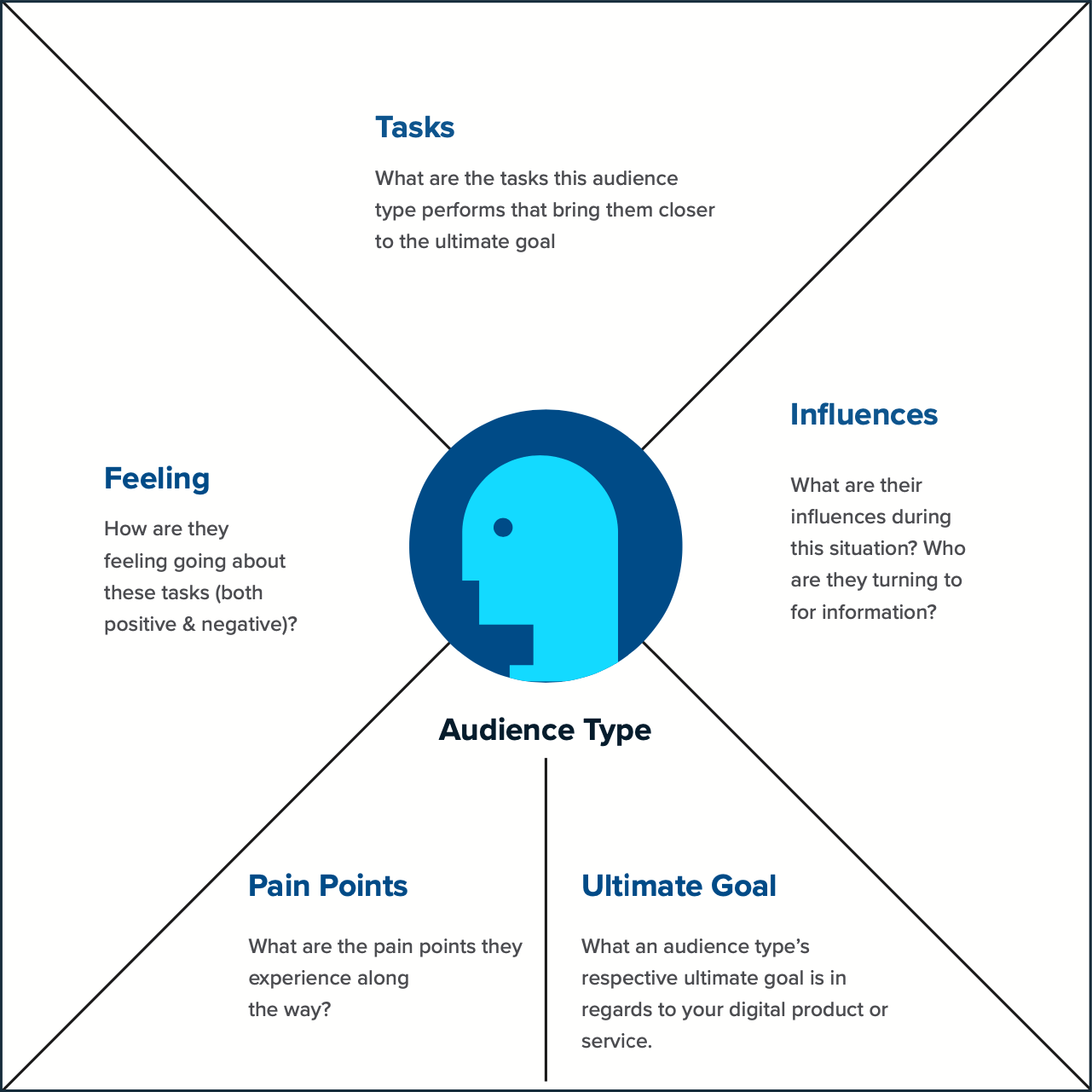
How to use Empathy Mapping in Moments of Crisis
- Product Design /
- Product Leadership /
In the beginning of any crisis, or any period of uncertainty there are always more questions than answers. The full magnitude of the crisis, the cause of the disaster, and the actions that people can take to protect themselves may be unclear. It has been no different with COVID-19.
During moments of crisis our bodies respond by flooding our system with hormones, boosting our alertness and heart rate, sending extra blood to the muscles, creating a state of readiness that helps us confront danger. In this responsive flash, the way we act, think, process and communicate is completely changed.
Frontline responders and community members have been working, learning and teaching in this crisis mode now for over eight months. They’re exhausted, stretched thin and scared. Hospitals are again beginning to fill beyond capacity. Rapid testing and contact tracing remain insufficient, and the process to find information and services is inconvenient and confusing at best, hugely disruptive to economies, communities, and families at worst. Little has changed since spring, except that the state of crisis has become a new normal.
In this document we will demonstrate how a design tool called Empathy Mapping can lead to valuable insights and help to align teams to tackle issues. It’s a powerful process that is used to externalize knowledge about users in order to create a shared understanding of user needs, discover gaps in your organization’s current knowledge and identify the types of research and action needed to address it.
In a matter of days, COVID-19 fundamentally reshaped the way we work, live, and socialize. It caused the world to accelerate the rate of change out of necessity. And, while there have been many failures to plan, let us not make the mistake to seize the opportunities before us to learn.
To make stronger systems that hold up in moments of crisis, now is the chance to learn from people who are in the midst of it. To do so, leaders will need to utilize a key facet that was absent prior to these significant changes that now needs to become an integral part of every organizations’ playbook. That key component is empathy.
What is Empathy
Empathy is about stepping into someone else’s shoes, letting go of our own biases, and seeking to understand a person via their unique point of view.
- Who are we empathizing with?
- What do they need to do?
- What do they see?
- What do they say?
- What do they do?
- What do they hear?
- What do they think and feel?
Developing empathy is at the heart of design thinking, and designing for moments of crisis. When you develop a deeper, more vital understanding of your audience, you are better equipped to build solutions that truly meet their needs.

If you want to dig deeper into the specifics of how to create an empathy map, visit our guide on how to use empathy mapping to create better digital products and services.
Empathy In Moments of Crisis
When you design for moments of crisis, you’re demonstrating respect and humanity for people who are living through difficult situations. By doing so, you cultivate contextual awareness that transforms your understanding and empowers your entire organization to create more impactful solutions.
In her TED Talk, Adrienne Boissy, Chief Experience Officer at the Cleveland Clinic, talks about the importance of empathy, and how it is not a soft skill, but an essential hard skill. In her talk Adrienne Boissy says, “Let’s do the hard work of listening to the emotional experiences of our patients, and our own people, and then make caring fixes back into every part of the healthcare system. That would require us to stop thinking of empathy as some sort of magical, elusive, cute, soft unicorn. And, start thinking of empathy — both the fixes and how we implement them — as something more fierce, more powerful, like a bull!”
Boissy points out the facts that when delivered properly, empathy has been proven to improve health outcomes. The human experience needs to be something that is much more humane. Boissy states, “Across the globe patients are just trying to survive. Not just the disease that brought them into the hospital, but the healthcare system itself. And, what’s worse, doctors and nurses are trying to survive it too.”
The Beginning Of Transformation
When you engage with customers through the practice of empathy, you can begin to understand how to deliver data-driven, customer-focused experiences in a crisis, that solve real problems. Practicing empathy can also be the beginning of organizational transformation.
In the COVID-19 era, leading with empathy will build a foundation of knowledge that is non-departmentalized—one that you share with your audiences.
Empathy helps to build alignment with the team, and empower employees. It’s the first step in understanding where to focus your research, in order to identify opportunities to deliver lasting impact.
Locating various points in the user’s journey will help you deliver caring and seamless experiences to your customers in crisis. Ultimately, this will help you optimize workflows, and transform your product and process to properly meet a multitude of needs.
Empathy Mapping The COVID-19 Crisis
In a moment of crisis or uncertainty, environments get intense and chaotic and capturing data becomes extremely difficult. However, we need to capture the data and details from these moments if we are to design organizations that are more resilient, responsive, and prepared to serve people in moments of crisis. This work informs a solid foundation from where to begin solving problems and building solutions.
In April 2020, just a few weeks after COVID-19 exploded onto the national stage in the United States, Emerge Interactive set out to speak to healthcare workers and community members. In this case study we interviewed frontline health workers that are working directly with COVID-19 patients. We broke out of our local city, and state and spoke to individuals all over the country to get a bigger picture of what’s going on.
We utilized the empathy mapping framework as our foundation to categorize and make sense of the research as we interviewed people. Empathy mapping is generally the first step in any design process, used internally to establish common ground among team members and stakeholders. It externalizes knowledge about a customer in order to create a shared understanding of customer needs, discover gaps in current knowledge and aid in decision making. In this case we used it as our means to quickly create questions, collect information, and analyze.
Our goal was to put ourselves into the shoes of healthcare workers and community members, in order to come as close to their experiences as possible. Doing so allowed us to capture vital feedback in the early days of the pandemic. We followed our curiosity to see what insights we could glean to create better experiences for hospitals, businesses, and community members to better plan, prepare, and navigate the crisis.
Key questions included:
- What are your daily tasks at work and at home?
- What does a typical day look like during the pandemic?
- What are your daily and weekly goals?
- What are the biggest barriers to accomplishing your tasks?
- What’s happening in your work and home environments right now?
- What are your interactions like?
- What are people saying?
- Who is influencing you?
- Where do you get your information about the pandemic?
- Where do you look for inspiration?
- What are your biggest frustrations about this situation?
- Biggest concerns/fears?
- What would make things easier?
We then analyzed results, and pulled out key insights and takeaways that helped us understand the following:
- The impact of what was happening on an individual/personal level.
- Whether or not individuals felt supported by leaders and organizations.
- What organizations could do differently in order to plan for future crisis moments.
In moments of crisis, we need frameworks in our toolbox that are force multipliers. Tools that can be leveraged to help uncover big insights quickly, help align teams in identifying problems to build stronger products and better systems, and to ultimately deliver more resilient organizations. The information that follows demonstrates how you can apply the empathy mapping tool to your organization’s own customer research.
Takeaways
- Empathy is not a soft skill and should be at the forefront of all design thinking.
- Leading with empathy results in an impactful change.
- When things go wrong, there’s an opportunity to learn.
- Trust in a system is important. Don’t take it for granted.
- Don’t underestimate designing for crisis and outlier scenarios. They can have a big impact.
- Delivering flexibility and adaptability in products or services will be important.
- Change has been accelerated out of necessity.
- Now is our opportunity to learn and build for the future.
The Domino Effect That Led To Mistrust
- National Awareness of a Lack of Resources
Leadership realizes there would not be enough resources to handle a full national pandemic. - Change in Protocols
National regulatory organizations ease restrictions on FDA protocols. - Lack of National Pandemic Procedures
Lack of national pandemic procedures along with changes in FDA protocols creates a questioning of authority and leadership from hospital leadership to the President of the United States. - No Trusted Central Sources of Communication
“The word of god has been rescinded”. National, regional, and local level safety policy failures cause frontline responders to question leadership ability to protect them. - Personal Safety Measures Taken
With policies broken, frontline responders take the fight for protection personally. Personal safety and family are first concerns. Closest leadership and other frontline workers are now trusted sources of info. - Central Source of Communication is Now Broken
With everybody doubting national leadership, people are now looking to alternate sources for information. - No Longer Working as a National Effort
Response is very regional/local. Knowledge sharing is happening more between doctors and nurses that are in the worst locations and sending it around the world.
Recommendations
This is a complex situation that we are experiencing with COVID-19 and due to the lack of planning for this type of situation we are having to deal with a problem that very few of us have experience with. We are all learning on the job and looking for help.
Our hope is that this example of empathy mapping will inspire you to engage with stakeholders in your organization. Talk to staff, talk to audience members, particularly in this moment of crisis. Use this moment to capture what’s going wrong, and how people are feeling.
Empathy mapping while a simple tool can offer huge results. It also doesn’t have to take that long to see results and build alignment within your stakeholders. Empathy mapping externalizes knowledge about a specific audience in order to create a shared understanding of their needs, what they are thinking, feeling, seeing, hearing, and doing.
Change is happening fast. It’s hard to do the work and innovate to meet the need. If you can’t take on the work internally, I urge you to look for help. Now is the time to begin the research to build stronger systems, better products, and more caring services for people under crisis.